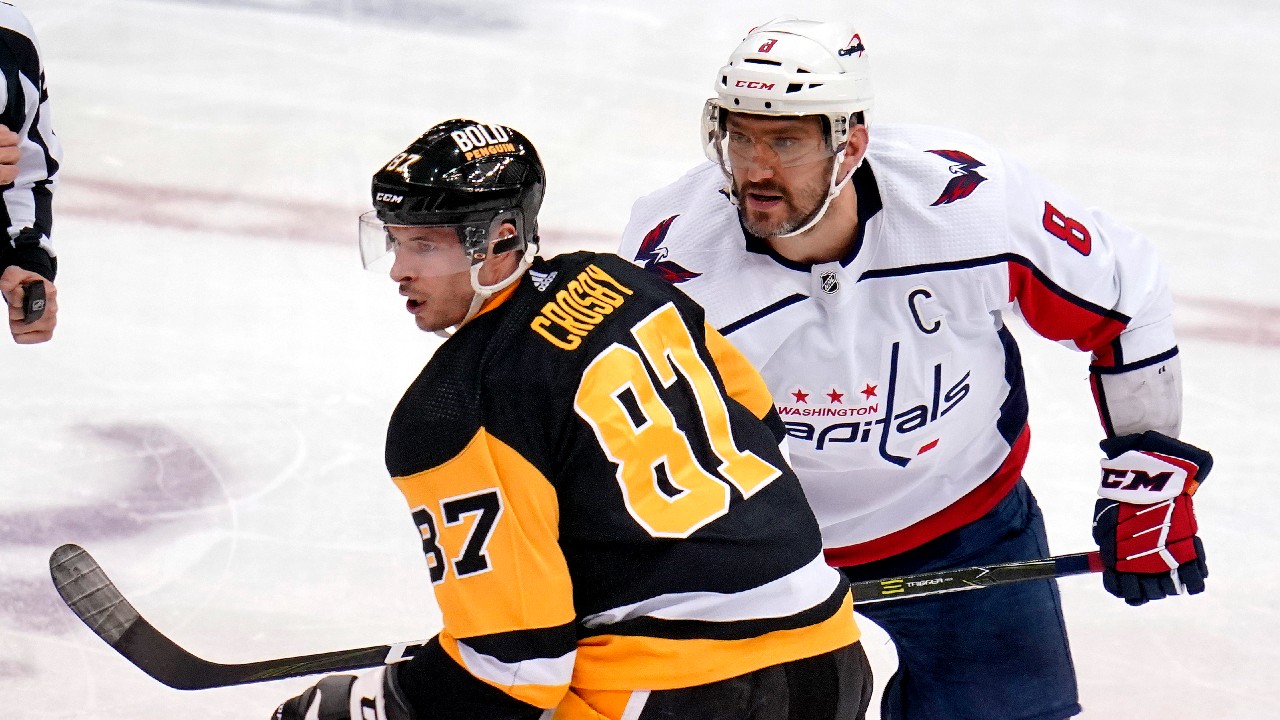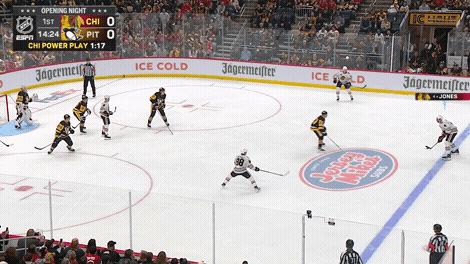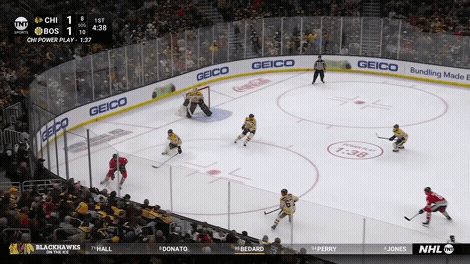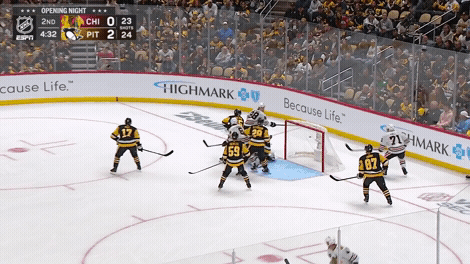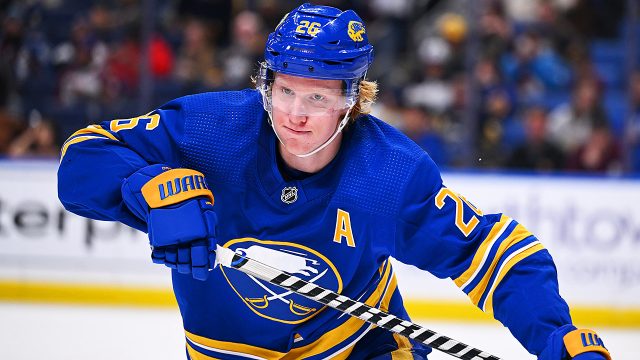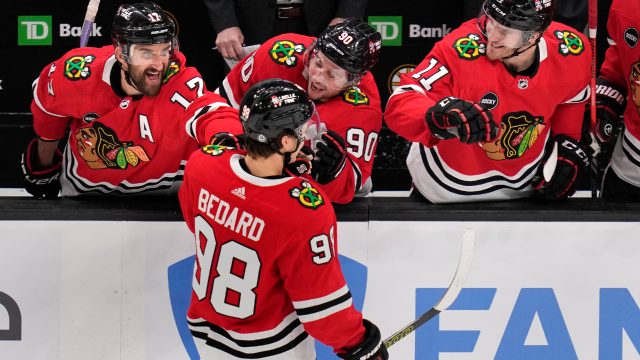
The Friday Four, a collection of thoughts and information on some intriguing player performances, returns this week with notes on:
• The Buffalo Sabres made big bets on a core of players before achieving even a playoff berth — and it could be the decision that positions them to win in the coming years.
• Connor Bedard is getting a veteran’s respect on the power play, but he’s found other ways to create for his team.
• And Patrik Laine is now a centre. But before you scoff at the move, know he’s come in with a different attitude this season and the Blue Jackets think the position change could elevate him to the next level.
RASMUS DAHLIN AND OWEN POWER
With a chunk of Erik Karlsson’s full-freight $11.5-million cap hit being retained by the San Jose Sharks, that means next season Drew Doughty and Rasmus Dahlin will have the highest cap charges to their teams among all NHL defencemen. Doughty signed his long-term deal five years ago at age 28, after he had won a Norris Trophy, two Olympic golds and two Stanley Cups.
Dahlin will be 24 when his eight-year extension kicks in, and though GM Kevyn Adams declared Buffalo’s window “open,” getting that first Stanley Cup this season is probably a long shot. The Norris, maybe not so much — on FanDuel at least, Dahlin entered the season with the third-best odds to win the best defenceman award.
A few days later, the Sabres extended Owen Power for seven years and an $8.35-million AAV after just one full season and six total goals. Now, Buffalo is set to have two of the 15 highest cap hits among all NHL defencemen next season, spent on players who have no awards, by a team that hasn’t qualified for the playoffs in over a decade.
And these deals are most likely both to be smash successes.
Between Dahlin, Power, Tage Thompson (seven years, $7.142 million) and Dylan Cozens (seven years, $7.1 million), Adams has identified a core of young players and made his bet on these two centres, a franchise defenceman and another No. 1 pick who may fully be worth his cost as soon as this season.
It comes with some risk, of course, but if Adams’ projections on these players are right, dare we say the Sabres will be in fantastic position to contend.
“What we’re tying to get across to Rasmus and others we negotiate with, we’re also trying to build a team around the player and give ourselves the opportunity to be set up for sustainable success,” Adams said this week. “That’s critical because I don’t look at one player, one contract, I’m trying to think of this in totality.”
Dahlin’s deal itself will be something of a bar-setter for young, star blueliners in the next stage of the NHL’s salary-cap era. Already, we’re looking at the cap ceiling rising by over $4 million next season, and it could take a similar jump in 2025-26. In that environment, Dahlin and Doughty probably won’t have the highest cap hits for much longer.
This is also why buying in big and early to the right players could be hugely advantageous for a franchise — not just because they’ll have control over their difference-makers, but also more room with which to build around them.
If we combine next year’s cap hits for Thompson, Cozens, Dahlin, Power and the Sabres’ other highly paid player, Jeff Skinner ($9 million), the total cap commitment is $34.24 million.
Now, they have their top two defencemen and top two centres locked in, which are often the most difficult positions to find solid players for. And the commitment to this five-man core accounts for 48.5 per cent of next year’s projected $87.7-million ceiling. (And we should note having Mattias Samuelsson signed long-term at $4.285 million is pretty solid as well.)
That percentage compares rather well against Tampa Bay and Colorado in the seasons they won their Stanley Cups under an $81.5-million cap ceiling.
When the Lightning won back-to-back Cups in 2020 and 2021, they had a core five of Nikita Kucherov ($9.5 million), Steven Stamkos ($8.5 million), Andrei Vasilevskiy ($9.5 million), Victor Hedman ($7.875 million) and Brayden Point ($6.75 million) combining to make $42.125 million against that ceiling — or 51.69 per cent. Point’s deal expired and he was extended with a $9.5-million cap hit that began last season and, as we know, the slow-rising cap also contributed to the Lightning having to lose valuable depth pieces to free agency, even though it’s accepted their star players took less to stay.
In 2022, the Avalanche were greatly aided by the fact they had their top two centres on bargain contracts: Nathan MacKinnon at $6.3 million and Nazem Kadri at $4.5 million. Add the next three core pieces (Gabriel Landeskog at $7 million, Mikko Rantanen at $9.25 million and Cale Makar at $9 million), and Colorado’s $36.05-million commitment to those five came to 44.2 per cent of the cap.
However, after winning, they immediately had to almost double MacKinnon’s cap hit, then lost Kadri to free agency. Now Colorado’s top five account for 52.7 per cent of a slightly elevated $83.5-million cap ceiling.
|
TEAM (SEASON) |
CORE 5 CAP HITS |
CAP CEILING |
% OF CAP TO CORE |
|
Tampa (2019-20) |
$42.125M |
$81.5M |
51.69 |
|
Colorado (2021-22) |
$36.05M |
$81.5M |
44.2 |
|
Tampa (2023-24) |
$45.5M |
$83.5M |
54.5 |
|
Colorado (2023-24) |
$43.975M |
$83.5M |
52.7 |
|
Buffalo (2024-25) |
$42.59M |
$87.7M (projected) |
48.5 |
The big difference between the Sabres and those two is that they still have a lot of runway here. Maybe they’ll need all of it before these players are “ready to win” it all, but this is a wide, seven-year window for the GM to build a contender with. That percentage of the cap committed to the core will only decline from here. Just imagine what the cap could be in four years, when the Sabres will still have Thompson, Cozens, Dahlin and Power on these deals for a couple more seasons!
But they haven’t accomplished anything yet, so it’s a bold way to build a team and, in that sense, Buffalo could be comparable to New Jersey in the years ahead. The Devils, too, committed big money to a core and their top five actually earn slightly less than Buffalo’s ($40.925 million or 46.6 per cent of next year’s cap).
In a cap world, that’s the competitive advantage you need.
Take rival Toronto, for example. While they surely banked on the salary cap continuing to rise when all their contracts were signed, their core five of John Tavares ($11 million), Auston Matthews ($11.64 million), William Nylander ($6.962 million), Mitch Marner ($10.903 million) and Morgan Rielly ($7.5 million) took up 58.9 per cent of the flat $81.5-million ceiling, and 57.5 per cent of this year’s upper limit. We know how they’ve struggled to find the right mix of talent to support the core with, and now extensions for most of those players will come as the cap increases again.
Advantage Buffalo.
“You’re putting a puzzle together, and when we do this, we look at one, two, three years, but we’re also projecting out past that,” Adams said. “The more certainty you have of where your salaries are structured and how you’re building your team, gives you more opportunity to add from the outside, or internally with your own guys.”
The players have to deliver on the promise, but they are starting from a good place. Thompson nearly scored 50 last season, Cozens delivered 31 goals in his third season, Dahlin scored nearly a point per game last season and Power might this season live up to his next contract.
Other contracts are still to come (what happens in net is a huge question) but Adams doesn’t have to worry about enormous deals for this core group over what’s expected to be a salary cap boom period. He has made his big bets on his most important players and, if it pays off, further moves will set this team up to be a force for some time.
CONNOR BEDARD
Through two games, the rookie sensation has two points, both of which came at even-strength. The early returns on the player are fantastic, with the promise of more to come.
Even for a “generational” type of player, if Bedard is going to hit or overachieve on pre-season expectations, he’s eventually going to have to start pouring in power-play points. Look at some of the best rookie seasons in the salary cap era and, at minimum, we should expect Bedard to score roughly 31 per cent of his points on the man advantage.
|
PLAYER |
TOTAL POINTS |
PP POINT PERCENTAGE |
|
Sidney Crosby |
102 |
46% |
|
Alex Ovechkin |
106 |
49% |
|
Mat Barzal |
85 |
31.7% |
|
Artemi Panarin |
77 |
31.2% |
|
Connor McDavid |
48 |
31% |
(Note: Ovechkin’s and Crosby’s high percentage can be attributed to the fact that 2005-06 had a much different standard for penalties and that power-play opportunities were handed out at by far the highest rate of the cap era.)
So far, the Blackhawks have spent 14 minutes on the power play and Bedard leads the team with 9:42 of ice time in that situation. They don’t have a PP goal yet, however, and Bedard doesn’t have a shot on goal with the man advantage.
Bedard’s reputation precedes him and though he’s an 18-year-old rookie, he appears to be getting the same respect of a veteran scorer the way he’s urgently defended by penalty killers. Of all Bedard’s skills, his shot is celebrated most, and so in Game 1 against Pittsburgh, where Bedard largely occupied Alex Ovechkin’s office on the left side of the power play, the Pens were quick to jump into his space.
Generationals aren’t one-trick ponies, though, and so what we’ve also seen from Bedard is his creativity to get around these checks and find the advantage an aggressive defence leaves behind.
In Game 2 against Boston, the Hawks barely were able to get settled in the offensive zone for the PP, so we didn’t see much of how tightly he’d be defended on the flank. But we did get a glimpse of that creativity against tight checking, as Bedard spun off the defender on this play, got the puck to his unchecked teammate in open ice and created an advantageous position for the Hawks to generate a high-quality scoring chance.
In fact, the first point Bedard ever recorded in the NHL — at even-strength — was a great example of how he can use a sticky defence to find a scoring advantage for his teammates.
“He’s so dangerous and even climbing high in the O-zone on the (Ryan) Donato goal, he was so dangerous the whole shift and people gravitate to him defensively and it let (Alex) Vlasic walk down freely and get a good shot, and Donato just worked his butt off in the crease and got the goal, but it starts with Connor really moving and being creative,” head coach Luke Richardson said after Tuesday’s win.
The respect he’s been getting is well-earned, and his shiftiness and confidence is apparent. There will surely be times during the 82-game grind when the battle becomes tougher for the kid, but his intelligence and ability to find an open teammate is another skill that sets him apart.
PATRIK LAINE
Since trading Pierre-Luc Dubois to Winnipeg in 2021, the Columbus Blue Jackets have been hard up at centre, seeking someone to be a play-driver and difference-maker in the top six. Several players were tried there, but the fit hasn’t come yet. Then they bottomed out last season, ended up with the third overall draft pick, and landed Adam Fantilli, who many projected as the No. 2-ranked prospect.
Fantilli, it’s thought, is the long-term 1C and he’d start getting his looks there right away.
But when the Blue Jackets opened on Thursday night, Fantilli was their third-line centre. And that’s because of a pre-season development nobody saw coming: Patrik Laine, the winger acquired for Dubois, wanted to give centre a shot.
“This is all Tage Thompson,” The Athletic‘s Blue Jackets beat reporter Aaron Portzline said on “The Jeff Marek Show” Thursday. “This is Laine looking at Thompson’s explosion last season and saying, ‘Huh, how bout that?’”
Now, at first you may not take that too seriously. Laine a centre? A position that requires diligence, two-way accountability and a well-rounded skill set that includes, but goes far beyond, the ability to shoot the puck in the net?
But Jackets head coach Pascal Vincent is very familiar with Laine. Vincent, who took over for Mike Babcock before training camp, was also with Laine in Winnipeg as an assistant coach. After discussing Laine’s desire for a position change, Vincent gave him the opportunity and it worked well enough in pre-season games for the coach to keep it going into the regular season.
There might be something different about Laine this season. Is he more comfortable? Aware that he’s an “older” player now and needing to assume a leadership position? Mad that the past few seasons haven’t broken his way, and motivated to correct that?
After Fantilli was drafted, Laine was the one who invited the youngster to stay at his pad.
“I would have never guessed that,” said Portzline, who wrote a great piece about Laine’s evolution. “I would have guessed Kuraly, Werenski, Jenner. I would have 12 guys before I got to Laine. He has carried himself with a different air this year.”
Heck, you can hear how Laine’s approach is different when he talks about the responsibility of playing down the middle.
“I feel like just try to make guys around me better. I don’t know how to do it yet, I haven’t played centre many times, but try to get them the puck as much as I can and be responsible defensively (so) they can do what they do best,” Laine said. “And, obviously, I think of myself as an offensive guy, too, but as a centre I have new responsibilities, so try to be worth the trust for my coaches and teammates.”
The Blue Jackets had a disappointing result in their opener, a 4-2 loss to Philadelphia, and no one really showed great. Laine won 40 per cent of his faceoffs, was a minus-1 and his top line was the Jackets’ worst when measured by 5-on-5 expected goals percentage. It’s a work in progress they hope leads to a bounce-back season.
“They found a way to integrate him at a new level and the centre position he’s really driven to make this work. If you’ve got a driven, motivated Patrik Laine, you’ve got a player and he has not put it all together yet in Columbus. He’s not stayed healthy and gone on those 40-goal barrages,” Portzline said. “There’s a feeling with many that this could be the year when he finally claims that in Columbus.”



